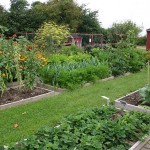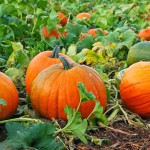It hardly seems possible but it’s already October, and appropriately enough this week I was out in the veg patch harvesting our pumpkins and squashes. The commercial food chain hasn’t really caught on to the stunning diversity of pumpkins and squashes that can be grown and savoured. Supermarkets have a depressing reliance on the ubiquitous Butternut squash and almost a complete absence of pumpkins other than the giant ones for carving for a few short weeks in October. It’s one of the great joys of GIYing therefore to be able to grow squashes and pumpkins of all shapes, sizes, colours and flavours.
I managed to grow about thirty fruits this year, ranging from the petite striped Delicata squash (handy cylindrical shape) to the eerie pale blue Crown Prince (the sweetest squash I’ve ever grown), to the supremely practical Baby Bear (high yielding small pumpkins) to the stunning red giant pumpkin Rouge Vif d’Etamps. I reckon that’s down about fifteen on the number I grew last year which could be a result of comparatively less fertility in the bed where I grew them this year or the miserable weather in July. Never mind, thirty fruits is a good result and (using one a week from November on) should see us through to April of next year. Thanks to their thick skins, pumpkins and squashes store very well—I store mine on top of the dresser in the kitchen which looks like a halloween display for about six months of the yeas as a result. Some years we’ve been eating squashes as late as April the following year. That makes them a very valuable crop.
It’s good to have them harvested and safely in out of the veg patch where they would be vulnerable to night time frosts (when they arrive). But on the downside, they looked absolutely stunning in the veg patch which suddenly seems rather dull by comparison. You can pick and eat pumpkin and squashes straight away fresh from the plant, but to store them for the winter, the fruit needs to develop a tough outer skin. It can be hard to know when they are ready to pick and it’s an important decision. Pick it too early and the fruit may lack flavour. Leave it too long and the the first frost will turn them to mush.
A good rule of thumb is to wait until they have developed a deep rich colour, the skins are hard and the leaves have died back. Leave about 10cm of stalk on the fruit, and then leave it for a further two weeks to cure somewhere dry and sunny—I leave mine on the shelf in the potting shed. The potting shed is now a glorious place to be—a stunning array of fruits of all shapes, colours and sizes. I know we should leave them be, and eat at a time of the year when there’s a scarcity elsewhere—but, I couldn’t resist making the squash salad below from a little Delicata squash and how delicious it was!
Grow at Work
This year we ran a Grow at Work campaign sponsored by our friends at Cully & Sully which saw teams of growers in over 400 companies all over Ireland growing peas on their desks at work with a free growing kit provided by GIY. We absolutely loved this campaign because (a) we’re always looking for ways to give people their first growing experience and (b) it really challenges people’s assumptions about where food can be grown. The top prize was won by a team called The Poddies (get it?!) from New Ireland who are donating their prize of a GIY Garden to a local Men’s Shed group. We’re already psyched for the 2016 campaign.
Growing food at work is a mindful, fun activity that can reduce stress, and improve mental and physical health. In the last year we’ve worked with companies to help them create a healthy, happy workplace where employees grow some of their own food. Some of the best places to work in Ireland such as Aramark, Genzyme, Diageo, Boston Scientific, Lake Region and Deloitte use workplace food growing programmes from GIY to help create a productive and happy work environment. More details at www.giyinternational.org/giyatwork.
Things to do this October
To Do
Pot up herbs to grow inside over the winter. Continue to lift crops that have finished harvesting and clean up the beds. Sow over-wintering green manures. If you are going to cover empty beds down with manure for the winter, the earlier you do it the better. Try and find a good source of farmyard manure if you don’t have your own—cow, horse, pig, sheep and chicken manure are all great sources of nitrogen, phosphorus and potassium for your soil. Cut autumn fruiting raspberry canes down to the ground.
Sow
You can sow hardy varieties of peas and broad beans later this month for an early spring crop but only do so in well-drained soil. In the polytunnel get a crop of cauliflower and carrots going over the winter. Plant selected varieties of garlic and winter onion sets.
Harvest
Depending on the weather, the harvest may well continue in to October—pumpkins, squashes, courgette, apples, pears etc. It’s the last hurrah however for peas, beans, tomatoes, cucumbers, aubergines, peppers and chilli-peppers. Continue to harvest wild mushrooms, elderberry, blackberries, sloes, carrots, potatoes, parsnips, swedes, celeriac, turnip, beetroot, celery, marrows, leeks and cabbage.
Recipe of the Month—Roasted Squash Salad with Spinach and Blue Cheese
Here’s a timely recipe that makes a centrepiece of the squashes that you’ve so lovingly grown over the season. I think this is tasty enough to serve by itself, perhaps with some warm crusty bread, cous cous or brown rice. Serves 4.
Ingredients
- 1/4 cup blue cheese, crumbled
- 3 tablespoons lemon juice
- Salt and ground black pepper to taste
- 1 1/2 teaspoon extra-virgin olive oil
- small red onion, thinly sliced
- Large handful baby spinach (chop if using large leaves)
- 1 small squash, peeled and cubed
Directions
Sprinkle the squash with some olive oil and then roast in a hot oven until tender and slightly browned—about 20 minutes. Use a fork to mash together blue cheese and lemon juice in a large bowl to make a thick smooth dressing. Season with salt and pepper; set aside. Heat the oil in a large frying pan over medium-high heat. Add the onions, salt and pepper, and cook, stirring occasionally, until golden brown, about 5 minutes. Add spinach and cook, tossing often, until slightly wilted and warm, 1 to 2 minutes. Transfer the contents of the pan to the bowl with the dressing, add the squash, salt and pepper and toss to combine.
Tip of the Month—Storing Pumpkin and Squash
Once cured, store your squashes and pumpkins in a dry place, temperature around 15°. Don’t stack them on top of each other, as they can rot where their skins meet—you want lots of air circulating around them. Kept like this they should keep for 4–6 months (keep an eye on them). The longer you can keep them the better because they are an incredible treat in the depths of winter—slicing in to a vibrant orange pumpkin is a great antidote to a grey, cold winter.
Join GIY
By joining GIY you help us to continue the work of supporting people just like you to grow food at home, at school, in the workplace and in the community—each year we support over 65,000 people and 1,500 community food growing groups and projects. It costs just €35 to join GIY for a year, and to say thanks we will send you a seasonal copy of our supporter’s magazine GROW and some GIY seeds for you to sow each quarter. We will also send you our weekly tips, news and advice ezine and offer you discounts to GIY events like the annual GROW Fest. Join today at GIYireland.com.
Michael Kelly is a freelance journalist, author and founder of GIY.
© GIY Ireland 2015—all rights reserved.




